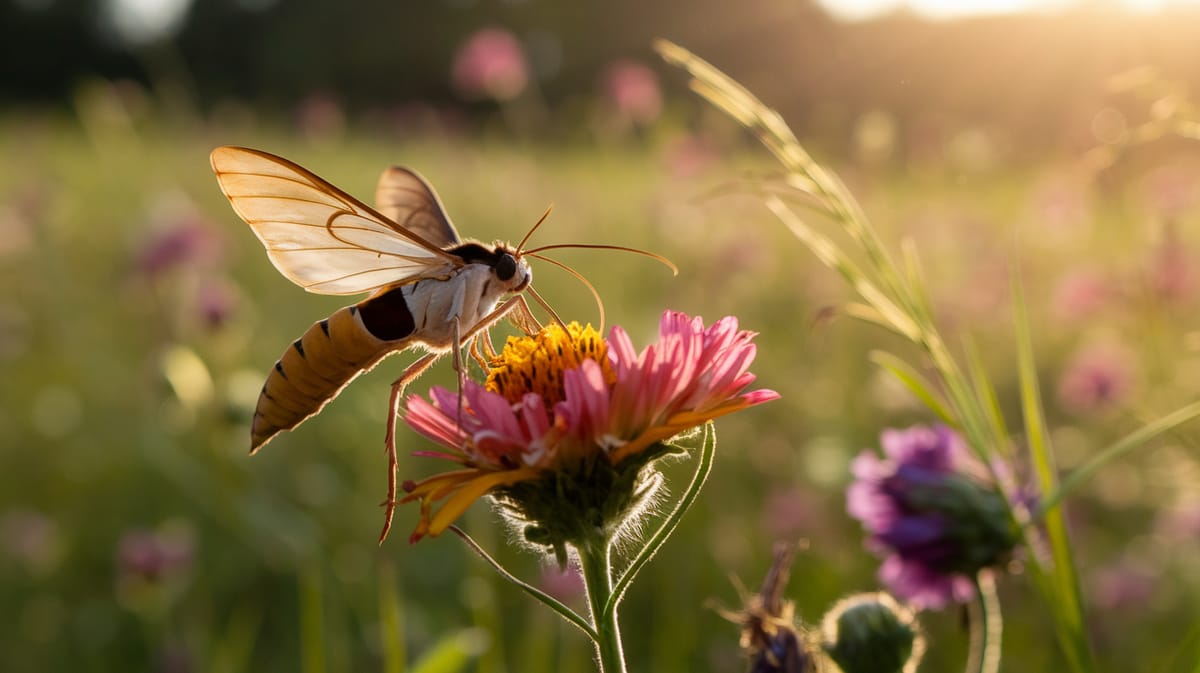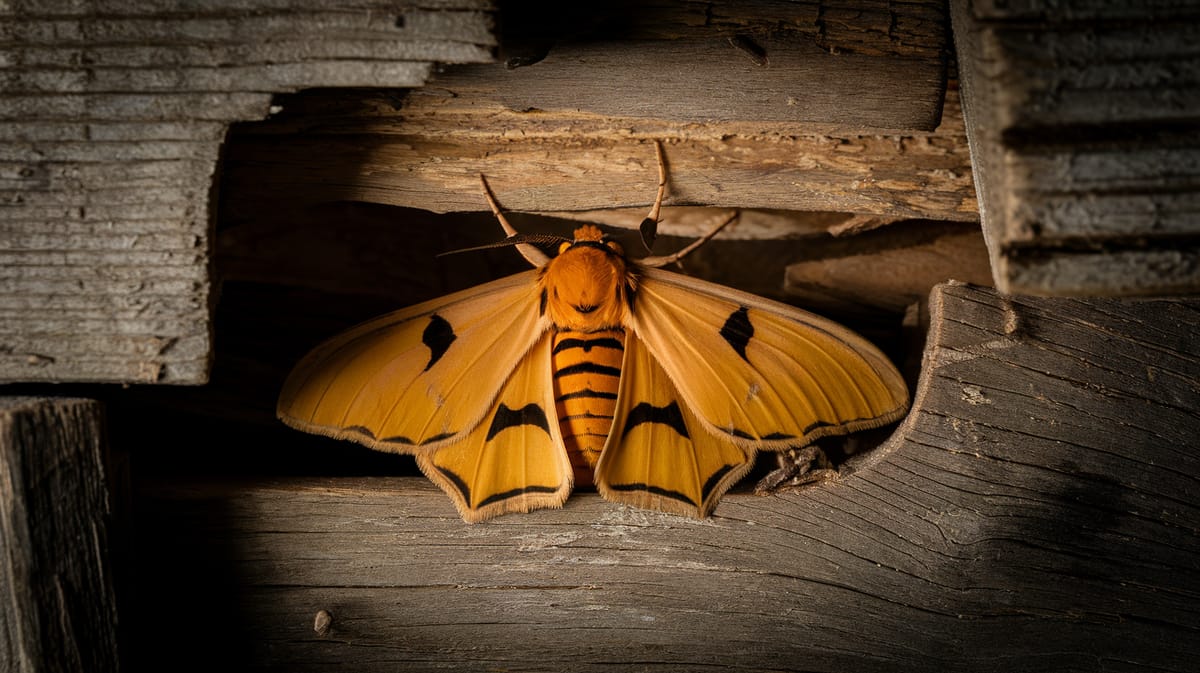Hornet Moth
Master of mimicry, the Hornet Moth resembles a stinging hornet, deterring predators with its convincing disguise. This moth plays a vital role in maintaining ecological balance.

Key Insights at a Glance
Did You Know?
Taxonomy & Classification
Hornet moths, mimicking hornets with their striking appearance, have evolved exceptional adaptations for survival and mimicry, enhancing their ecological roles as pollinators. Let's understand the evolutionary journey and classification of these remarkable pollinators.
Species Diversity
Comprising about 140 species in the genus Sesia, hornet moths are primarily distributed across Europe and parts of Asia.
Evolutionary Adaptations
Emerging around 100 million years ago, hornet moths have developed mimicry to evade predators and adapt to changing environments.
Lifecycle and Growth
A remarkable journey of transformation from Egg to Adult.
Egg
Tiny eggs are laid on the bark of host trees, where they remain hidden and protected until hatching.
Larva
Grub-like larvae tunnel into the tree, feeding on wood and growing while causing internal damage to their host.
Pupa
Pupation occurs within a protective casing near the tree's surface, preparing for the final transformation.
Adult
Adults emerge with clear wings and mimic wasps, focusing mainly on mating and laying eggs.
Dietary Habits
A mimic of hornets, this insect primarily consumes tree sap, with larvae feeding on woody plant tissues.
| DIET TYPE | DESCRIPTION |
|---|---|
| Primary Diet | Larvae feed on the inner bark and wood of trees, especially poplar and willow. |
| Secondary Diet | Occasionally consumes nectar from flowers, contributing to its energy intake in adult stages. |
| Occasional | Rarely feeds on fermented fruit juices, tapping into available sugars under specific conditions. |

Behaviour and Adaptations
Discover the fascinating adaptations that enable the Hornet Moth to thrive in its environment.
Mimicry Mastery
Resembles a hornet to deter predators, providing effective camouflage and protection.
Efficient Pollination
Contributes to pollination while collecting nectar, supporting plant reproduction.
Larval Wood Boring
Larvae bore into willow and poplar trees, ensuring a protected habitat.
Ecosystem Impact
Hornet Moths play a vital role in preserving ecological balance by influencing plant diversity and species interactions.
Larval Wood Decomposer
Larvae burrow into wood, aiding decomposition and nutrient cycling in forests.
Pollinator Support
Adults assist in pollination, boosting plant reproduction and genetic diversity.
Prey for Predators
Serves as a food source for birds and small mammals, sustaining local wildlife.
Conservation Challenges
Understanding and addressing the major threats to Hornet Moth populations.
Habitat Loss
Deforestation and urban development reduce the Hornet Moth's natural habitats.
Pesticide Use
Chemical pesticides harm Hornet Moth larvae and adults, reducing their numbers.
Climate Change
Temperature changes affect Hornet Moth breeding and food availability.
Frequently Asked Questions
How long do Hornet Moth live?
Hornet Moths have a relatively short adult lifespan, typically living for about one to two weeks. During this time, their main focus is to reproduce. The larval stage can last up to two years, during which they live inside the wood of host trees.
What do Hornet Moth eat?
Adult Hornet Moths do not eat, as they have reduced mouthparts and do not feed. The larvae feed on the wood and inner bark of host trees, such as willows and poplars, where they spend most of their developmental stage.
Are Hornet Moth poisonous?
Hornet Moths are not poisonous. They are harmless to humans and animals. Their resemblance to hornets is a form of mimicry, which helps deter predators by making them appear more threatening than they actually are.
Are Hornet Moth endangered?
Hornet Moths are not currently classified as endangered. They are considered to have a stable population in most regions where they are found. Conservation efforts focus on maintaining their natural habitats to ensure their continued survival.
What do Hornet Moth symbolize?
Hornet Moths symbolize transformation and mimicry in the natural world. Their striking resemblance to hornets highlights the evolutionary strategy of mimicry for survival. They also represent adaptation and the intricate connections within ecosystems.
Do Hornet Moth bite?
Hornet Moths do not bite. They are non-aggressive and harmless to humans. Their mimicry of hornets is purely visual and not associated with any aggressive behavior or biting capability.
What color are Hornet Moth?
Hornet Moths are primarily yellow and black, resembling hornets. This coloration helps them mimic the stinging insect and serves as a protective adaptation against predators. Their wings are transparent with dark veins and a wingspan of about 1.5 to 2 inches.
Does a Hornet Moth have wings?
Yes, Hornet Moths have wings. Their wings are transparent with dark veins and mimic the appearance of a wasp or hornet. This mimicry helps them avoid predators by resembling more dangerous stinging insects.
What does a Hornet Moth look like?
Hornet Moths have a striking resemblance to hornets, featuring yellow and black striped bodies and transparent wings with dark veins. Their appearance is an example of Batesian mimicry, where harmless species evolve to imitate the warning signals of harmful species.
Is a Hornet Moth an insect?
Yes, Hornet Moths are insects. They belong to the family Sesiidae and are part of the Lepidoptera order, which includes moths and butterflies. Like all insects, they have six legs, a segmented body, and undergo metamorphosis during their life cycle.
Related Insects
Discover insects with similar characteristics to Hornet Moth - including shared habitats, diets, and taxonomic classifications
Share this profile
Help others discover Hornet Moth
